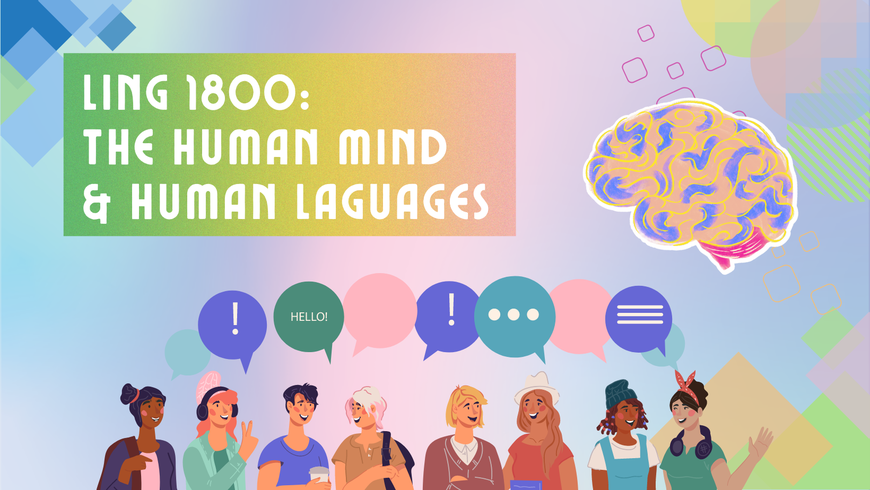Linguistics Fall 2023: Intro-Level Classes about Society, AI, the Human Mind and More
New: LING 1800 The Human Mind & Human Languages
What do languages across the world have in common and where do they differ? What do these similarities and differences between languages teach us about the human mind? What aspects of the mind and language connection are being modeled in AI innovations like ChatGPT? Let's Explore!
The ability to acquire and use language is a biological trait of the human species. This capacity for language manifests itself as thousands of particular languages spoken around the world in communities large and small. But what is language? What does it mean for a human to “know” a particular language? How do children acquire this knowledge? How do we use language to communicate? These are some of the important questions addressed by the field of linguistics, the scientific study of the human capacity for language in its physiological, cognitive, historical, and social manifestations.
Coursework in Linguistics can enrich your study of languages, computer science, psychology, anthropology, media, and many other areas. Graduates with linguistics background go on to work in a variety of industries, putting their linguistics knowledge to use in software engineering and AI, publishing, speech pathology, teaching, interpreting and localization, law, language revitalization, and beyond.
The Institute of Linguistics is offering LING 1800 and three other courses without prerequisites in Fall 2023. These courses are open to everyone.
In this course, we will examine the relationships between language and social variables such as age, sex and gender, race and ethnicity, socioeconomic status, geographic region, and others. We will highlight the implications of such relationships on a variety of social and societal dimensions, for example government policy, contact between speakers of different languages, processes of language loss and preservation, discrimination and language attitudes, and programs for social justice.
Our planet hosts around 7000 human languages. What do diverse languages across the world have in common and where exactly do they differ? What do these underlying similarities and differences between languages teach us about the human mind?
One school of thought argues that all human beings are genetically born with the ability to learn and use complex patterns in language, and thus languages share many universal properties. Another school of thought believes in the concept of “embodied cognition”, or the idea that human language cannot express things that the human mind cannot experience. In this course, we directly study both schools of thought and various topics that highlight the vital mind and language connection.
Topics of study will include:
- what role do language and cognition play in the development of thoughts?;
- how do different languages express numerical systems?;
- why are color naming systems so diverse across languages?;
- what role does human memory play in efficiently computing the different orders of words and sentences in languages?;
- Why are children so good at learning so many complexities of language, while adults are much slower?;
- What aspects of the mind and language connection are being modeled in Artificial Intelligence?
These and other topics will lead us into many modern day innovations. One example of that is ChatGPT, which was trained on 911 billion words, the equivalent of about 1000 years of non-stop reading. Thus, ChatGPT, the best computer model, required 1000 years worth of training to learn how to have human-like speech, while actual humans can do it in a few short years!
Innovations like these and many others show us that the relationship between human cognition and human languages is directly at the forefront of science today, and this relationship is our topic of study in this course.
This course is a guided tour through the vocabulary of English, one of the largest and most varied in any of the world’s languages. Among the questions it will address are: Why does English have so many (and so many different kinds of) words? Where did these words come from? Why do they mean what they mean? How are they put together? What do they tell us about history, social organization, culture and human psychology? One practical advantage of learning the answers to these and other questions is that it helps in vocabulary building and in demystifying specialized and technical terminology. The course is also a portal into linguistics, the study of the nature of language.
This course Introduces some of the essential findings of linguistics:
- All varieties of all languages are intricately structured at multiple distinct but related levels.
- This intricate structure can be described in terms that are not only precise, but which apply to all human languages.
We will work to replicate some of these findings by deploying simple analytical methods on data from a variety of languages. These methods allow us to answer questions about the different structural components of language:
- Phonology: how do speech sounds pattern?
- Morphology: what are possible words and how are they built?
- Syntax: what is the hierarchical structure underlying sequences of words?
- Semantics: how do more complex conceptions of meaning emerge?
Having characterized language as an intricately-structured system of knowledge, we will then possess the tools to ask a number of additional questions about language and cognition.
- How does such complex knowledge play into the actual task of sentence production or comprehension?
- What do we know about the neural implementation of this knowledge in human brains?
- How does child language acquisition proceed, and what makes it so much more robust than language acquisition later in life?
- Do animals have languages of their own? Can they learn human languages?
Finally, we will turn our attention to variation in language patterns observed over the passage of time, across geographical space, and within social systems.
- How and why do languages change over historical time?
- What can we know about languages spoken before the invention of writing?
- What distinctions exist between languages spoken in different places, and how can we tell whether similarities are due to genealogical relationships?
- How do new languages emerge?
- How do languages disappear?
- How does language use vary between individuals from the same place or the same community?
- How do socioeconomic class, ethnicity, and gender relate to the linguistic behavior of individuals?
- How does language policy affect educational outcomes?
- What about social cohesion and conflict?
Although we will find that most of these questions lack definitive answers, we will develop an understanding of what it takes to ask them meaningfully and precisely. In particular, we will be able to eliminate false or misleading answers, especially when they fail to take into account the observable and describable properties of the human capacity for language.



